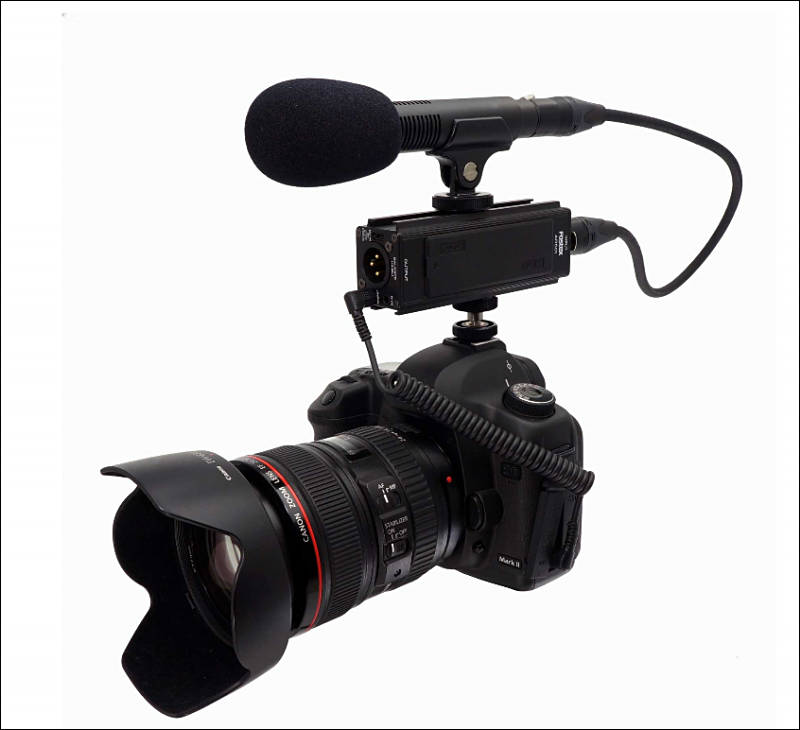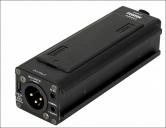
It allows to keep PV going, with more focus towards AI, but keeping be one of the few truly independent places.
-

- Selectable mic input gain level, -20 / -30 / -45 / -60dBu
- Phantom 48V power supply
- HPF at 80 or 160Hz with -6dB/oct
- Cascading function for stereo application with a supplied dedicated joint plate
- Balanced Out (+4dBu, XLR) and Unbalanced Out (-10dBV or attenuated -50dBV, stereo mini)
- Peak LED and Power LED that doubles with low battery warning
- Powered by 1 x AA battery (Alc or NiMH) for 10 hours operation (approx. 4 hours with P48V on) or DC-IN (5V, Micro USB)
- Power saving mode (phantom power down to 24V) to extend the operation hours
http://www.fostexinternational.com/docs/products/AR501.shtml

 photokina41.jpg800 x 730 - 48K
photokina41.jpg800 x 730 - 48K
 photokina42.jpg800 x 616 - 47K
photokina42.jpg800 x 616 - 47K -
You can get Fostex AR501 Mic Preamplifier now for $79 only
http://www.bhphotovideo.com/c/product/1012401-REG/fostex_ar501_mic_preamplifier_for.html
-
it says $349
-
Deal just ended, sorry, had been $79 an hour ago.
Amazon has one for $149
http://www.amazon.com/Fostex-Battery-Powered-Microphone-Preamplifier/dp/B00GFY6FMC/
-
$149 is a great price. I paid $200 for mine and it's worth every penny. Really good performer.
-
I use an AT AT897 connected to an Zoom H1. Compared to my Sennheiser ME 66 I have to raise the levels much higher which induces more noise. Would this preamp help me get more sensitivity out of my AT AT897 so I can reduce my levels lower than I would without it? And about how much? My Sennheiser is already 20dB levels lower than the AT AT897 to be equal.
-
The AT897 is 17 dB less sensitive than the ME66, according to the spec sheets. (18 dB less sensitive on battery power) Yes, absolutely, a pre-amp would let you turn the gain down on your Zoom H1, improving the signal to noise ratio of your recordings.
The Fostex AR501 has four gain settings for its balanced output: 24 dB, 34 dB, 49 dB, and 64 dB. The unbalanced output is 12 dB quieter than the balanced output, making the four gain settings effectively 12 dB, 22 dB, 37 dB, and 52 dB.
AT897 self noise at its output: -115 dBu (A-weighted)
AR501 equivalent input noise: -125 dBu (A-weighted)
Zoom H1 equivalent input noise (using gain of 37 or higher): -111 dBu (A-weighted)
The AR501's noise is much lower than the AT897's noise, so the AR501's noise won't be heard at all. At the AR501's minimum gain setting of 12 dB, the AT897's amplified self noise becomes 8 dB louder than the Zoom H1's. So the Zoom H1's noise won't be heard anymore. Using 12 dB of external pre-amplication means you can turn down the gain by 12 dB on the Zoom H1, in which case the self noise of the mic becomes the limiting factor. The AT897 is not an especially quiet mic. Using the AR501 improves the SNR by only about 4 dB compared to using the Zoom H1 connected directly to the AT897.
With an external pre-amp, you would want to set the Zoom H1's gain to 37, which maximizes its dynamic range. Then adjust the gain on the pre-amp. Without an external pre-amp, you need to set the Zoom H1's gain appropriately for the input signal.
-
@balazer Thanks for your detailed answers! You're awesome.
Is the Fostex AR501, the best mini-preamp around $200? I see Beachtek, IndiPro and Azden also make a few models.
-
You are welcome.
I think it depends on how you shoot. For me, personally, when I am shooting I have almost no mental capacity to be monitoring and adjusting audio levels. I'm just too busy worrying about framing, focusing, zooming, and exposure. So I want a pre-amp to be set-and-forget. The AR501 fits my shooting style very well. I love how small and light it is, and battery life is great. I get 7 hours with an old NiMH AA in power-saving mode with an AT875R. And I really like that it uses an AA instead of a 9V or something else. If you wanted to be continually monitoring the signal and adjusting the gain, a pre-amp with a more accessible gain control might be better. Though I believe you can use a simple and cheap in-line headphone volume control on the output of the AR501 if you really want a more accessible and continuously variable gain control. (haven't tested that yet but I'm pretty sure it would work) If you need stereo, I wouldn't choose the AR501. You can gang two of them for stereo, but I think that's an inelegant and expensive solution. For mono, the AR501 is great. Of course it's just a pre-amp, not a recorder. If you want a recorder, something like the Tascam DR-70D has incredible bang for your buck. But for my style of shooting, I usually want my audio going straight into the camera. An external recorder is something I only use when I'm recording music and the mics aren't on the camera.
Nitpicking, now: the battery cover is really poorly designed. It's soft clear plastic held to the pre-amp with the tiniest of nubs on the hinge. I fully expect the thing to just fall off someday. The good thing is that you don't really need it, so I just removed mine and I will save it for a rainy day. Switching between normal and power-saving mode is done with an unnecessarily complicated sequence of switch flipping that you'll hardly remember. I wish the AR501 had a limiter, but few devices in its class do. I wish it had a lower output level on one channel of the stereo unbalanced output, like current JuicedLink models do. ("audio level bracketing") But that can be added with a few resistors in a custom-made cable.
Bottom line, this is the smallest and lightest pre-amp with such low noise. It will take full advantage of whatever mic you plug into it, and it will outlast all of your cameras. At $350 it is a bit overpriced, but under $200 I consider it a great buy.
-
@balazer Thank you again!
Would it be beneficial to even pair the AR501 with a hot mic such as the Sennheiser ME66 or ME64? I would be using this with a Zoom H1 which is not known for its preamps.
-
there is a hack for the iRig Pre that does the same thing. In the UK you can buy them for less than £30: http://martinshakeshaft.com/blog/?p=959
-
The iRig Pre sounds like a great low cost option but the 9 volt battery! Why? Why?
-
iRig Pre specs say "Noise: -98 dB fullband, phantom power ON". I don't know what that means exactly, but it sounds like unweighted equivalent input noise in dBu, in which case its noise performance is really terrible and much worse than the Zoom H1. It's a cheap phantom power supply, but it will add noise.
ME66 self noise at the output: -108 dBu (unweighted). I'm not sure how to compare unweighted and A-weighted noise, but using a reasonable guess, the ME66 is just a little bit noisier than the Zoom H1. So you'd only gain a little by adding a quieter pre-amp.
Howdy, Stranger!
It looks like you're new here. If you want to get involved, click one of these buttons!
Categories
- Topics List23,980
- Blog5,725
- General and News1,352
- Hacks and Patches1,152
- ↳ Top Settings33
- ↳ Beginners255
- ↳ Archives402
- ↳ Hacks News and Development56
- Cameras2,362
- ↳ Panasonic992
- ↳ Canon118
- ↳ Sony156
- ↳ Nikon96
- ↳ Pentax and Samsung70
- ↳ Olympus and Fujifilm100
- ↳ Compacts and Camcorders300
- ↳ Smartphones for video97
- ↳ Pro Video Cameras191
- ↳ BlackMagic and other raw cameras115
- Skill1,960
- ↳ Business and distribution66
- ↳ Preparation, scripts and legal38
- ↳ Art149
- ↳ Import, Convert, Exporting291
- ↳ Editors191
- ↳ Effects and stunts115
- ↳ Color grading197
- ↳ Sound and Music280
- ↳ Lighting96
- ↳ Software and storage tips266
- Gear5,417
- ↳ Filters, Adapters, Matte boxes344
- ↳ Lenses1,580
- ↳ Follow focus and gears93
- ↳ Sound498
- ↳ Lighting gear314
- ↳ Camera movement230
- ↳ Gimbals and copters302
- ↳ Rigs and related stuff273
- ↳ Power solutions83
- ↳ Monitors and viewfinders340
- ↳ Tripods and fluid heads139
- ↳ Storage286
- ↳ Computers and studio gear560
- ↳ VR and 3D248
- Showcase1,859
- Marketplace2,834
- Offtopic1,319
Tags in Topic
- preamp 8
- fostex 7
- preamplifier 1




